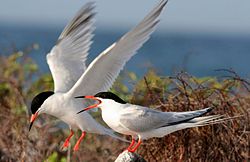Roseate tern
| Roseate tern | |
|---|---|
 |
|
| Scientific classification | |
| Kingdom: | Animalia |
| Phylum: | Chordata |
| Class: | Aves |
| Order: | Charadriiformes |
| Family: | Sternidae |
| Genus: | Sterna |
| Species: | S. dougallii |
| Binomial name | |
|
Sterna dougallii Montagu, 1813 |
|
The roseate tern (Sterna dougallii) is a seabird of the tern family Sternidae. The genus name Sterna is derived from Old English "stearn", "tern", and the specific dougallii refers to Scottish physician and collector Dr Peter McDougall (1777–1814). "Roseate" refers to the bird's pink breast in breeding plumage.
English naturalist George Montagu described the roseate tern in 1813. Genetically, it is most closely related to the white-fronted tern (S. striata), with their common ancestor a sister lineage to the black-naped tern (S. sumatrana).
This species has a number of geographical races, differing mainly in bill colour and minor plumage details.
S. d. dougallii breeds on the Atlantic coasts of Europe and North America, and winters south to the Caribbean and west Africa. Both the European and North American populations have been in long term decline, though active conservation measures have reversed the decline in the last few years at some colonies, most notably at Rockabill Island off the coast of Dublin, Ireland, which now holds most of the European population (about 1200 pairs).
The tropical forms S. d. korustes and S. d. bangsi are resident breeders from east Africa across the Indian Ocean to Japan. They have more red on the bill. The long-billed and short-winged S. d. gracilis breeds in Australia and New Caledonia. The north-western Indian Ocean holds populations of S. d. arideensis. Some authors suggest that only three races arideensis, gracilis and nominate dougallii should be retained.
This is a small-medium tern, 33–36 cm (13–14 in) long with a 67–76 cm (26–30 in) wingspan, which can be confused with the common tern, Arctic tern, and the larger, but similarly plumaged, Sandwich tern. The roseate tern's thin sharp bill is black, with a red base which develops through the breeding season, and is more extensive in the tropical and southern hemisphere races. It is shorter-winged and has faster wing beats than common or Arctic tern. The upper wings are pale grey and its under parts white, and this tern looks very pale in flight, like a small Sandwich tern, although the outermost primary flight feathers darken during the summer. The adults have very long, flexible tail streamers and orange-red legs. In summer, the underparts of adults take on the pinkish tinge which gives this bird its name.
...
Wikipedia

